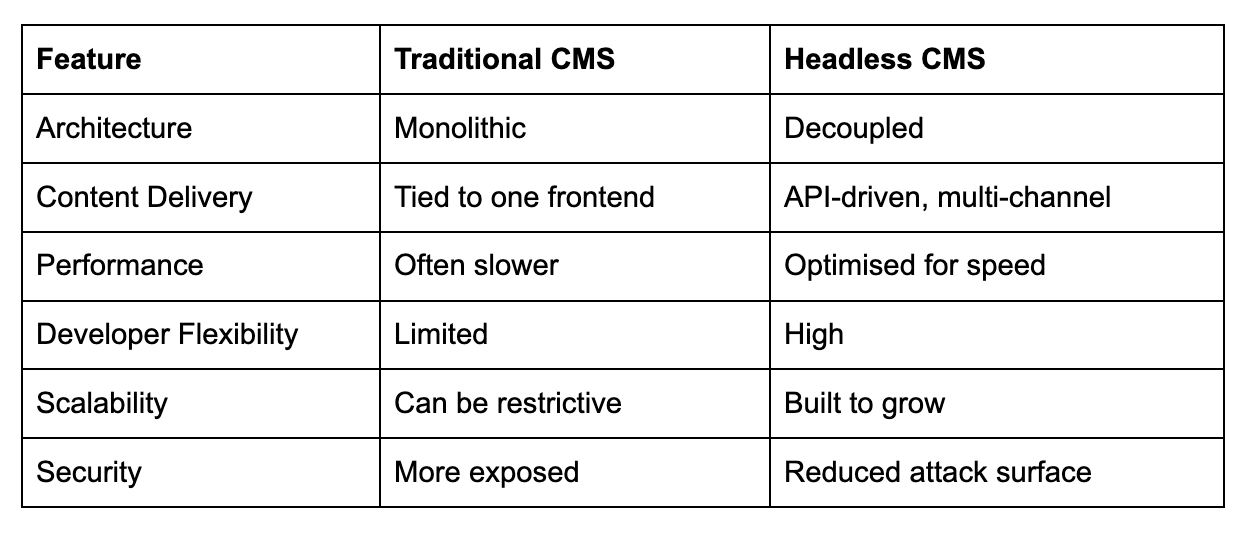
As digital experiences grow more complex and fragmented, the systems we use for managing content need to evolve and adapt. Traditional content management systems (CMS) have done a job that's 'good enough' for years, but many are now reaching their limits, especially when it comes to speed, flexibility, and scalability.
At evensix, we’ve seen demand for headless (also known as API-first, decoupled or composable) CMS skyrocket over the past 4-5 years. Nobody used the term or knew what it was. We’ve been saying it for years, and it seems now it’s gathering pace as the term is searched for over 12,000 times a month.
For organisations looking to deliver content across multiple platforms, adapt quickly to change, and improve performance, headless CMS is a compelling alternative.
What’s a headless CMS?
A headless CMS separates the backend content repository from the frontend presentation layer. Instead of pushing content to a specific website template, it delivers content via APIs to any platform: websites, mobile apps, smart devices, and more.
Think of it like a library: the content is stored in one place, but can be checked out and displayed in many different formats depending on the audience and context.
This approach gives developers more freedom to build custom frontends using modern frameworks, while content editors continue to manage content in a familiar interface.
Limitations of traditional CMS
Most traditional CMS platforms are monolithic, which means the backend (where content is created) and the frontend (where it’s displayed) are tightly connected. This setup can work well for simple websites, but it often becomes a bottleneck as digital needs grow.
Common challenges include:
- Slow page load times, especially on mobile
- Limited flexibility in design and layout
- Difficulty publishing content across multiple platforms
- Frustration from developers working within rigid templates
- Challenges scaling or integrating with newer technologies
- Multiple users can’t edit the same page at the same time
These issues often lead teams to explore more modern, decoupled approaches to content management.
We see this day in and day out. Lots of our clients had been dealing with inefficiencies and duplication of effort when designing and publishing content. It makes it impossible to scale with any kind of pace.
Traditional CMS vs. headless CMS
Here’s a simple comparison table to highlight the key differences:

8 benefits of a headless CMS
1. You can create better experiences
A headless CMS allows for flexible and dynamic content delivery, powering personalised, real-time and contextually relevant user experiences across multiple channels.
2. Improved performance
Headless architectures often support static site generation and server-side rendering, which can lead to faster load times and better performance metrics. Especially important for SEO and user experience.
3. Flexible publishing and increased efficiencies
Content can be created once and automated to be published across multiple platforms, reducing duplication and streamlining workflows.
4. Enhanced security
By decoupling the backend from the frontend, headless CMSs reduce the number of exposed endpoints, which can help lower security risks.
5. Developer autonomy
Developers can use modern tools and frameworks without being constrained by legacy CMS templates, making it easier to build tailored experiences.
6. Scalability
As the digital requirements of your business grow, your team may not. Whether that’s adding new channels, integrating third-party tools, or expanding globally, headless CMSs are built to be futureproof and scale with your business.
7. Avoids technology lock-in
Because the frontend and backend are decoupled, your CMS is not stuck with a specific tech stack, so you have the flexibility to choose the best tech for the job.
8. Reduced errors
A headless CMS centralises content management, which can automatically post content to different channels, reducing the risk of copy-paste mistakes and human error.
Is headless right for your business?
While headless CMS offers many advantages, it’s not a one-size-fits-all solution. Here are a few considerations to help determine if it’s a viable solution for your business, and of course, whether it’s the right time in its evolution:
Do you have the technical resource or support to manage setup and integration?
Headless CMSs are developer-centric by nature. They offer flexibility, but in return they require technical expertise to set up APIs, connect front ends, and manage infrastructure. Without the right team or support, implementation can stall or become costly. We get a lot of clients who come to us for help untangling their convoluted CMS set ups, so we know first hand just how crucial this step is.
There’s also an advantage to the editor of the CMS. It’s not just a developer tool, and can be really intuitive if it’s set up correctly.
Are you delivering content across multiple platforms or devices?
If you're publishing to websites, mobile apps, smart devices, or even digital signage, a headless CMS is a no-brainer. By allowing you to manage content centrally and push it anywhere via APIs, there’s no need to duplicate or reformat content manually.
Are your developers limited by the current CMS?
Traditional CMSs often come with rigid templates and frontend constraints. A headless approach frees developers to build custom experiences using modern frameworks (like React or Next.js), without being boxed in by legacy systems. Great developers are hard to find (and keep), so make sure they have what they need to do their job well.
Is performance and scalability a priority for your business?
Headless architectures are built for speed and scale. When you decouple the frontend, you can boost performance (e.g. quicker load times and improved SEO), while also scaling up globally with CDN support, all without putting too much strain on your CMS backend.
If the answer to most of these is yes, it might be worth exploring whether headless CMS is right for you in one of our exploratory headless CMS workshops.
Take a look at how one of our clients, Rowse Honey, saw a 246% increase in total impressions, 76% increase in click throughs and 92.78% increase in session duration shortly after the new headless version of their site went live.

